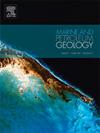Seismic evidence for magmatism-driven mud volcanism in the northern continental margin of the South China Sea
IF 3.6
2区 地球科学
Q1 GEOSCIENCES, MULTIDISCIPLINARY
引用次数: 0
Abstract
The Chaoshan Depression in the northern South China Sea (SCS) margin is abundant with submarine mud volcanoes, and hosts two primary sets of hydrocarbon source rocks within its thick Mesozoic strata. However, the driving mechanism for submarine mud volcanism there remains enigmatic. Here multichannel seismic and ocean bottom seismometer data of line CS-L1 across several mud volcanoes in the Chaoshan Depression are processed and analyzed. Beneath the mud volcanoes, several vertical fuzzy reflection zones are imaged within the Mesozoic strata. They feature distinctly lower velocities than their host strata, and are interpreted as mud diapirs formed by vigorous fluid infilling. High-velocity bodies (HVBs) with Vp > 7.0 km/s are widely imaged below the lower crust and interpreted as post-drift magma underplating bodies. Beneath the mud volcanoes, a thicker HVB extending upward to the depth of ∼15 km is observed, implying locally stronger magma underplating. Moreover, the overlying crust of this thicker HVB also features higher velocities than the surrounding crust. This crustal high-velocity zone extends upward to the shallow depth of ∼9 km, probably representing local magma intrusions sourced from the underlying magma underplating body. This strong association between the submarine mud volcanism and the stronger deep magma underplating and intrusion indicates that the mud volcanism in the Chaoshan Depression of the northern SCS margin was probably magmatism-driven. The deep magma underplating and intrusion firstly caused the surface uplift and the formation of high-angle normal faults. Subsequently, the heat from these intruded magmas promoted hydrocarbon gas generation of the Mesozoic source rocks and increased the pore-fluid pressure, generating mud diapirs within the Mesozoic strata with abundant fluid charging. The submarine mud volcanoes were finally formed with abundant fluids migrating from these mud diapirs to the seafloor along the high-angle faults.
南海北部大陆边缘岩浆驱动泥火山作用的地震证据
南海北部边缘潮汕坳陷海底泥火山丰富,在其厚的中生代地层中发育两套主要烃源岩。然而,海底泥火山作用的驱动机制仍然是一个谜。本文对潮汕坳陷多个泥火山的CS-L1线多道地震和海底地震仪资料进行了处理和分析。在泥火山之下,在中生代地层中形成了若干垂直模糊反射带。它们的速度明显低于其寄主地层,被解释为由剧烈流体充填形成的泥底辟。带Vp >的高速体(HVBs);7.0 km/s的岩浆在地壳下广泛成像,并被解释为后漂移岩浆底板体。在泥火山下方,观测到一个较厚的HVB向上延伸至约15公里的深度,这意味着局部岩浆底板更强。此外,这个较厚的HVB的上覆地壳也具有比周围地壳更高的速度。这一地壳高速带向上延伸至~ 9 km的浅层深度,可能代表了源自下伏岩浆下覆体的局部岩浆侵入。这种海底泥火山活动与较强的深部岩浆底垫和侵入的强烈联系表明,南海北缘潮汕坳陷泥火山活动可能是岩浆活动驱动的。深部岩浆底镀和侵入首先引起地表隆升,形成高角度正断层。随后,这些侵入岩浆的热量促进中生代烃源岩生烃,增加孔隙流体压力,在流体充注丰富的中生代地层内形成泥底辟。海底泥火山的形成是由于大量的流体从这些泥底辟沿高角度断裂向海底迁移而形成的。
本文章由计算机程序翻译,如有差异,请以英文原文为准。
求助全文
约1分钟内获得全文
求助全文
来源期刊

Marine and Petroleum Geology
地学-地球科学综合
CiteScore
8.80
自引率
14.30%
发文量
475
审稿时长
63 days
期刊介绍:
Marine and Petroleum Geology is the pre-eminent international forum for the exchange of multidisciplinary concepts, interpretations and techniques for all concerned with marine and petroleum geology in industry, government and academia. Rapid bimonthly publication allows early communications of papers or short communications to the geoscience community.
Marine and Petroleum Geology is essential reading for geologists, geophysicists and explorationists in industry, government and academia working in the following areas: marine geology; basin analysis and evaluation; organic geochemistry; reserve/resource estimation; seismic stratigraphy; thermal models of basic evolution; sedimentary geology; continental margins; geophysical interpretation; structural geology/tectonics; formation evaluation techniques; well logging.
 求助内容:
求助内容: 应助结果提醒方式:
应助结果提醒方式:


